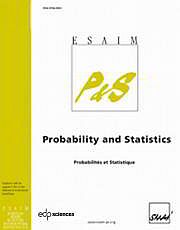Crossref Citations
This article has been cited by the following publications. This list is generated based on data provided by Crossref.
Clémençon, Stéphan
Lugosi, Gábor
and
Vayatis, Nicolas
2005.
Learning Theory.
Vol. 3559,
Issue. ,
p.
1.
Biau, G.
Bunea, F.
and
Wegkamp, M.H.
2005.
Functional Classification in Hilbert Spaces.
IEEE Transactions on Information Theory,
Vol. 51,
Issue. 6,
p.
2163.
Balcan, Maria-Florina
and
Blum, Avrim
2005.
Learning Theory.
Vol. 3559,
Issue. ,
p.
111.
Takigawa, Ichigaku
Kudo, Mineichi
and
Nakamura, Atsuyoshi
2005.
Machine Learning and Data Mining in Pattern Recognition.
Vol. 3587,
Issue. ,
p.
90.
Biau, Gérard
and
Bleakley, Kevin
2006.
Statistical inference on graphs.
Statistics & Decisions,
Vol. 24,
Issue. 2,
p.
209.
Vaart, Aad W. van der
Dudoit, Sandrine
and
Laan, Mark J. van der
2006.
Oracle inequalities for multi-fold cross validation.
Statistics & Decisions,
Vol. 24,
Issue. 3,
p.
351.
Herbei, Radu
and
Wegkamp, Marten H.
2006.
Classification with reject option.
Canadian Journal of Statistics,
Vol. 34,
Issue. 4,
p.
709.
Fromont, Magalie
and
Tuleau, Christine
2006.
Learning Theory.
Vol. 4005,
Issue. ,
p.
94.
Peski, Marcin
2006.
Categorization.
SSRN Electronic Journal,
Lecué, Guillaume
2006.
Learning Theory.
Vol. 4005,
Issue. ,
p.
364.
Abraham, C.
Biau, G.
and
Cadre, B.
2006.
On the Kernel Rule for Function Classification.
Annals of the Institute of Statistical Mathematics,
Vol. 58,
Issue. 3,
p.
619.
Lecué, Guillaume
2007.
Simultaneous adaptation to the margin and to complexity in classification.
The Annals of Statistics,
Vol. 35,
Issue. 4,
Lounici, K.
2007.
Generalized mirror averaging and D-convex aggregation.
Mathematical Methods of Statistics,
Vol. 16,
Issue. 3,
p.
246.
Lecué, Guillaume
2007.
Learning Theory.
Vol. 4539,
Issue. ,
p.
142.
Audibert, Jean-Yves
and
Tsybakov, Alexandre B.
2007.
Fast learning rates for plug-in classifiers.
The Annals of Statistics,
Vol. 35,
Issue. 2,
Wu, Qiang
Ying, Yiming
and
Zhou, Ding-Xuan
2007.
Multi-kernel regularized classifiers.
Journal of Complexity,
Vol. 23,
Issue. 1,
p.
108.
Bousquet, Olivier
and
Elisseeff, André
2007.
Guest editorial: Learning theory.
Machine Learning,
Vol. 66,
Issue. 2-3,
p.
115.
Lecué, Guillaume
2007.
Optimal rates of aggregation in classification under low noise assumption.
Bernoulli,
Vol. 13,
Issue. 4,
Bauer, Frank
Pereverzev, Sergei
and
Rosasco, Lorenzo
2007.
On regularization algorithms in learning theory.
Journal of Complexity,
Vol. 23,
Issue. 1,
p.
52.
Juditsky, A.
Rigollet, P.
and
Tsybakov, A. B.
2008.
Learning by mirror averaging.
The Annals of Statistics,
Vol. 36,
Issue. 5,


